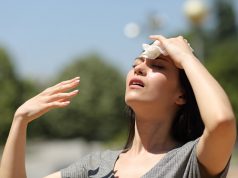Screening Out the Sun
Getting the Facts from Dr. Amin Sharobim
By Hilary Diack
Who can resist the holiday combination of summer, sea and sand? Each year millions of holiday-makers travel thousands of miles to bask in radiant sunshine, chasing the perfect tan. So, what’s the catch? Too much sun exposure can create lasting skin damage and has associated health risks. Cairo West Magazine learns more about protecting our largest organ with leading dermatologist Dr. Amin Sharobim.
CWM: Dr. Amin, Is there a difference in the type of sun-block protection that men and women need?
There are important common factors to bear in mind for all family members. It is important to use a protective sunscreen that suits your own skin type – oily or dry – and sensitivity level. There is no essential difference for products that are suited to men or women if you follow those guidelines. Anyone with dry skin needs to choose a sunscreen with a high level of moisturizer, whether lotion or cream. In addition to an SPF of 30+, your sunscreen should include some combination of the following UVA-blocking ingredients: zinc oxide, titanium dioxide, avobenzone, ecamsule, & oxybenzone. Sunscreens with both UVA and UVB protection may be labelled multi spectrum, broad spectrum, or UVA/UVB protection. For best protection, we recommend using a minimum SPF sunscreen of 15, applying the proper amount (2mg/cm2 of skin, or about one ounce for full body coverage) at least 20 minutes before direct sun exposure, and reapply every 2 hours.
What are specific protection guidelines for very young children?
Children, of course, have delicate skins that are in need of a sun-block with a factor of SP30+ up to SP 50+, while containing a minimal amount of chemicals. These tend to contain natural products, and are put on in a layer that physically coats the skin and deflects the sun’s rays. It is important when choosing a product to try it on a small patch of skin and leave for at least half an hour to see if there is any adverse reaction before applying it all over. Look for broad spectrum protection from UVA and UVB rays using the safe mineral zinc oxide, avoiding oxybenzone, octinoxate, or other chemical active sun-screening agents. Very young children should ideally be kept in the shade and covered with loose protective clothing.
What do we need to know about the harmful effects of over exposure to direct sunlight?
UV radiation reaches the earth in the form of UVB and UVA rays. UVB radiation plays a key role in skin cancer and is the chief culprit behind sunburn, while UVA rays, which penetrate the skin more deeply, are associated with wrinkling, leathering, sagging, and other light-induced effects of aging (photo-aging). They also exacerbate the carcinogenic effects of UVB rays, and increasingly are being seen as a cause of skin cancer on their own. Sunscreens vary in their ability to protect against UVA and UVB. SPF refers mainly to the amount of UVB protection a sunscreen offers. Thus, higher SPFs can help: An SPF 15 sunscreen blocks 93 percent of UVB radiation, while an SPF 30 sunscreen blocks nearly 97 percent. Above SPF 50 (which blocks an estimated 98 percent of UVB rays), the increase in UVB protection is minimal. Furthermore, higher SPF values offer some safety margin, since consumers generally do not apply enough sunscreen. To evaluate SPFs, testers apply two milligrams of sunscreen per square cm of skin. But in everyday life, most people apply from only 0.5 to one milligram per square cm of skin. Consequently, the actual SPF they achieve is approximately 1/3 of the labelled value. Sunscreens with a higher SPF should offer more protection from the sun’s harmful ultraviolet (UV) radiation, which is linked to the vast majority of skin cancers, as well as premature skin aging and eye damage.
How important a role does natural skin tone play in the ability to deal with UV rays?
Here in Egypt, like many of our Mediterranean neighbours, we are fortunate generally to have a higher level of melanin in our skin, giving most of us a naturally olive complexion. This helps us cope with the constant sunshine and high temperatures, making us less likely to burn when exposed. This does not mean we can lie around in the sun with impunity, but we are less likely to burn than fairer-skinned visitors.
A lot of people are expressing concern about ingredients in commercial sun protection products, what are the chemicals to avoid?
There can be severe allergic reactions to products containing Para-aminobenzoic acid, so it may be best to check the label carefully before applying. Effects can include coma, diarrhea, Dizziness, eye irritation if it touches the eyes, fever, liver failure, nausea, rash (allergic), shortness of breath, slowed breathing, stupor (altered thinking and decreased level of consciousness) and vomiting. Many of the chemicals in sunscreens may create allergies, so again, please carry out a small skin test first.
There is a trend towards natural products for tanning. What is your opinion of these: i.e. coconut oil?
Dermatologists will firmly advise patients to avoid any form of tanning, including the use of sun-beds. The use of any oil, no matter how organic, in helping you fry yourself, is putting your skin and health at risk.
What is the best remedy for sunburns?
When you have suffered from over-exposure, go for a good moisturiser with high levels of anti-oxidants. Many of these contain aloe vera, which is known for its’ soothing properties.
Apart from topical products, what are the top tips you can give on avoiding excess exposure to the sun?
Wear loose light-colored clothing in natural fabrics like cotton and linen. Wear a hat, and remember that even on a cloudy day you are catching UV rays.
What are the best times of day to be out in direct sunlight?
It is important to avoid the hours between 11 am and 4 pm. The sun is at its strongest between those hours, and you can burn very quickly. Try to enjoy the beach earlier in the morning (when it s often less crowded), or in the late afternoon.
Are there any nutritional items that can assist our skin in keeping healthy in summer?
Load up on fresh seasonal fruits and vegetables, they will keep you hydrated and give you the antioxidants you need to help your skin repair itself. In recent tests certain nutrients, such as the antioxidant vitamins C and E, have been found to help prevent, and repair cellular damage caused by ultraviolet radiation. Eating foods that are high in these vitamins on a day that you’ll be out in the sun might actually prevent or lessen the severity of a sunburn! You get the best protection if you have both of these vitamins in your system at the same time, but they are hardly ever found in the same foods. You get vitamin C from tomatoes, red and green peppers, melons, citrus fruit, and broccoli. Vitamin E, on the other hand, is found in avocados, almonds, and sunflower seeds.





